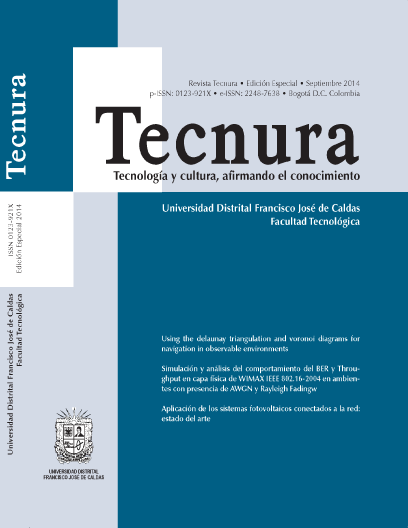DOI:
https://doi.org/10.14483/udistrital.jour.tecnura.2014.SE1.a03Publicado:
01-12-2014Número:
Vol. 18 (2014): Edición EspecialSección:
InvestigaciónCuantificación de existencias de compuestos bifenilos policlorados (PCB) en Colombia
Stocks quantification of polychlorinated biphenyl compounds (PCB) in Colombia
Descargas
Resumen (es)
Los compuestos bifenilos policlorados, más conocidos como PCB, son sustancias de alta toxicidad tanto para el ser humano como para los ecosistemas. El Convenio de Estocolmo sobre Contaminantes Orgánicos Persistentes (COP), entre los que se encuentran los PCB, establece la necesidad de que los países tomen medidas para reducir o eliminar el uso de equipos eléctricos que aún funcionen con PCB. Por esta razón, el Ministerio de Ambiente de la República de Colombia (MINAMBIENTE) desarrolló un inventario sobre las existencias globales de PCB en uso. En este artículo se presentan la metodología seguida y los resultados consolidados de dicho inventario. El informe indica que las existencias estimadas de PCB en Colombia están entre 9.771 y 12.803 toneladas.
Resumen (en)
Polychlorinated biphenyl compounds (PCB) are high toxicity substances for humans as well as for ecosystems. The Stockholm Convention on Persistent Organic Pollutants, including PCB, establishes the need for countries to reduce or eliminate the use of electrical equipment that still operates with PCB. Thus, the Ministry of Environment, Housing and Territorial Development in Colombia (MINAMBIENTE) conducted a preliminary inventory of PCB in use. This article presents the methodology and results of this inventory. The report shows that estimated stocks of PCB in Colombia are among 9.771 and 12.803 tons.
Referencias
Boix, J., & Cauli, O. (2012). Alterations of serotonin system by polyclorinated biphenyls exposure. Neurochemistry International, 809-816.
Chiu-Yueh, Y.; Tien-Shang, H.; Kao-Chang, L.; Pei-Chien, T., & Yue Leon, G. (2011). Menstrual effects among women exposed to polychlorinated biphenyls and dibenzofurans. Environmental Research, 288-294.
Clarke, B. O.; Porter, N. A.; Marriot, P. J., & Blackbeard, J. R. (2010). Investigating the levels and trends of organochlorine pesticides and polychlorinated biphenyl in sewage sludge. Environment International, 323-329.
Delistraty, D. (2013). Ecotoxicity and risk to human fish consumers of polychlorinated biphenyls in fish near the Hanfore Site (USA). Science of the Total Environment, 14-21.
Dodoo, D. K.; Essumang, D. K., & Johathan, J. W. (2013). Accumulation profile and seasonal variations of polychlorinated biphenyls (PCBs) in bivalves Crassostrea tulipa (oysters) and Anadar senilis (mussels) at three different aquatic habitats in two seasons in Ghana. Ecotoxicology and Environmental Safety, 26-34.
Hopf, N. B.; Ruder, A. M., & Sucoop, P. (2009). Background levels of polychlorinated biphenyls in the U.S. population. Science of the Total Environment, 6109-6119.
Librando, L.; Minniti, Z.; Acolla, M. L.; Cascioc, O.; Castelli, F., & Sarpietro, M. G. (2013). Calorimetric evaluation of interaction and absorption of polychlorinated biphenyls by biomembrane models. Chemosphere, 791-796.
MINAMBIENTE (2007). Inventario preliminar de compuestos bifenilos policlorados en Colombia. Bogotá: Ministerio de Ambiente, Vivienda y Desarrollo Territorial.
Mohammed, A.; Peterman, P.; Echols, K.; Feltz, K.; Tegerdine, G.; Manoo, A.; Orazio, C. (2011). Polychlorinated biphenyls (PCBs) and organochlorine pesticides (OCPs) in harbor sediments from Sea Lots, Port-of-Spain, Trinidad and Tobago. Marine Pollution Bulletin, 1324-1332.
PNUMA (2005). Eliminando los COP del mundo: guía del Convenio de Estocolmo sobre Contaminantes Orgánicos Persistentes. Ginebra: Programa de las Naciones Unidas para el Medio Ambiente.
Remer, M., & Boekelheide, K. (2013). Multiple environmental chemical exposures to lead, mercury and polychlorinated biphenyls among childbearing-aged women (NHANES 1999-2004): Body burden and risk factors. Environmental Research, 23-30.
Seeger, M.; Timmis, K. N., & Hofer, B. (1997). Bacterial pathways for degradation of polychlorinated biphenyls. Marine Chemistry, 327-333.
Shimura, M.; Koana, T.; Fukuda, M., & Kimbara, K. (1996). Complete degradation of polychlorinated biphenyls by a combination of ultraviolet and biological treatments. Journal of Fermentation and Bioengineering, 573-576.
UNEP (1999). Guidelines for the identification of PCBs and materials containing PCBs. Ginebra: United Nations Environment Programme.
UNEP (2003). Preparación de un plan nacional de manejo ambientalmente adecuado de los bifenilos policlorados (PCB)y de equipos contaminados con PCB. Ginebra: United Nations Environment Programme.
Zanaroli, G.; Balloi, A.; Negroni, A.; Daffonchio, D.; Young, L. Y., & Fava, F. (2010). Characterization of the microbial community from the marine sediment of the Venice lagoon capable of reductive dechlorination of coplanar polychlorinated biphenyls (PCBs). Journal of Hazardous Materials, 417-426.
Cómo citar
APA
ACM
ACS
ABNT
Chicago
Harvard
IEEE
MLA
Turabian
Vancouver
Descargar cita
Licencia
Esta licencia permite a otros remezclar, adaptar y desarrollar su trabajo incluso con fines comerciales, siempre que le den crédito y concedan licencias para sus nuevas creaciones bajo los mismos términos. Esta licencia a menudo se compara con las licencias de software libre y de código abierto “copyleft”. Todos los trabajos nuevos basados en el tuyo tendrán la misma licencia, por lo que cualquier derivado también permitirá el uso comercial. Esta es la licencia utilizada por Wikipedia y se recomienda para materiales que se beneficiarían al incorporar contenido de Wikipedia y proyectos con licencias similares.


